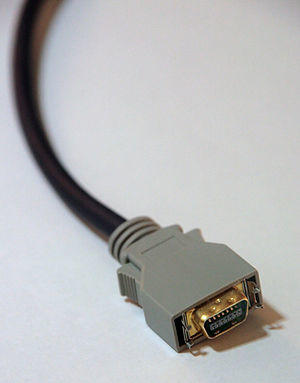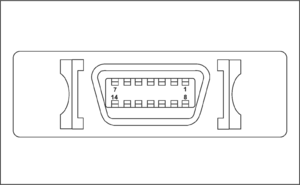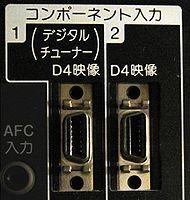 A male D video connector. | |||
| Type | Analogue video connector | ||
|---|---|---|---|
| Production history | |||
| Designer | EIAJ (Electronic Industry Association of Japan) | ||
| Designed | Late 1990s | ||
| Produced | Late 1990s to present | ||
| Superseded | RCA connectors | ||
| General specifications | |||
| Audio signal | device depending | ||
| Video signal | Analogue component video, digital 480i, 480p, 720p, 1080i | ||
| Pins | 14 (6 video, 3 reserved, 2 detect, 3 data) | ||
| Data | |||
| Data signal | Resolution and Aspect ratio information | ||
| Pin out | |||
 | |||
| A female connector seen from the front. | |||
| Pin 1 | Y | luminance (0.7 V, 75 Ω) | |
| Pin 2 | Y GND | Y ground | |
| Pin 3 | PB | 0.35 V, 75 Ω | |
| Pin 4 | PB GND | ||
| Pin 5 | PR | 0.35 V, 75 Ω | |
| Pin 6 | PR GND | ||
| Pin 7 | Reserve link 1 | ||
| Pin 8 | Data line 1 | 0 V = 525 lines 2.2 V = 750 lines 5 V = 1125 lines | |
| Pin 9 | Data line 2 | 0 V = 59.94i / 60i 5 V = 59.94p / 60p | |
| Pin 10 | Reserve link 2 | ||
| Pin 11 | Data line 3 | 0 V = 4:3 2.2 V = 4:3 letterbox 5 V = 16:9 | |
| Pin 12 | Plug insert detect ground | ||
| Pin 13 | Reserve link 3 | ||
| Pin 14 | Plug insert detect | output 10 kΩ, input > 100 kΩ | |
| Hooks | GND | Shell ground | |
The D-Terminal or D-tanshi (D端子) is a type of analog video connector found on Japanese consumer electronics, typically HDTV, DVD, Blu-ray, D-VHS and HD DVD devices. It was developed by the EIAJ (Electronic Industry Association of Japan) in its standard, RC-5237, for use in digital satellite broadcast tuners. In appearance it is a small flat trapezic connector, the same connector as the AAUI connector used by Apple Computer for some time to connect to ethernet.
Some items sold outside Japan use the connector as well. Notable examples are Canon's XH-A1 DVC high-definition camcorder and Panasonic's AG-HVX200 DVCPro HD camcorder.
D1~D5 types

A D-Terminal connector carries a component video signal (YPBPR). A device with a D5 connector can understand and display the following video signals:
- D1 480i (525i): 720 × 480 interlaced
- D2 480p (525p): 720 × 480 progressive
- D3 1080i (1125i): 1920 × 1080 interlaced
- D4 720p (750p): 1280 × 720 progressive
- D5 1080p (1125p): 1920 × 1080 progressive
A device with a D-Terminal connector supports that level and lower D-Terminal signal. For example, a D4 connector can be used with a D4, D3, D2, or D1 signal, but not with a D5 signal.
It is possible to use a simple breakout cable to connect a D-Terminal connector to a standard 3 RCA jack or BNC component connection.[1]
Compatibility Questions
With the aforementioned diagrams, consumers should take careful consideration regarding the input and output terminals. Purchased products such as the PlayStation Portable (PSP-2000) are equipped with the (D2) interface. However, since the release of System Software Ver.5.00, the interface has been changed to (D1). Since 2010, the PSP's I/O system has adopted the progressive I/O interface. Furthermore, the PSP-3000 marks the possibility of interlace I/O.
See also
- Amphenol connector
- D-subminiature
References
- ^ D-Terminal to Component cable adapter Archived 2009-01-16 at the Wayback Machine